The Microsoft Surface Laptop 3 (15-Inch) Review: AMD Ryzen Surface Edition
by Brett Howse on October 21, 2019 9:00 AM EST- Posted in
- Laptops
- AMD
- Microsoft
- Surface
- Ryzen
- Surface Laptop
- Surface Laptop 3
Battery Life
Microsoft outfits all of the Surface Laptop 3 models with just a 46 Wh battery, which is actually slightly smaller than the one in the Surface Laptop 2, and all despite this 15-inch model being physically larger. Microsoft has also changed their battery testing methodology from a basic local video playback time, to a more realistic workload, so if you’re looking at the Microsoft spec pages, expect to see a lower runtime advertised as well.
The original Ryzen 2000 Raven Ridge platform had some serious power management issues, and this will be our first test of any Picasso based laptops, since AMD hasn’t had a lot of big design wins previous to this one for their second generation Ryzen APU.
Light Web

The 15-inch Surface Laptop 3 achieves just a touch under nine hours of runtime in our least-intensive battery test, with the display set to our standard of 200 nits brightness. While nine hours is a reasonable amount of time, it’s still well under the results from the smaller 13.5-inch Surface Laptop 2 we tested, which achieved almost 12 hours. That is a significant difference, of which some could likely be accounted by the larger display, which would inherently require more power to get to 200 nits, but it’s too big of a discrepancy to rest only on the display.
2016 Web
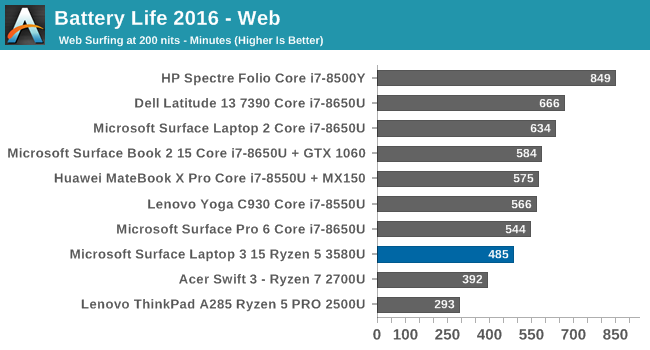
Our newer web test is much more CPU intensive, and a more realistic result than the older, lighter test. As expected, the results dropped further, to just over eight hours of usage, which is still a reasonable amount of time, but well under the 10.5 hours achieved by the Surface Laptop 2.
Movie Playback
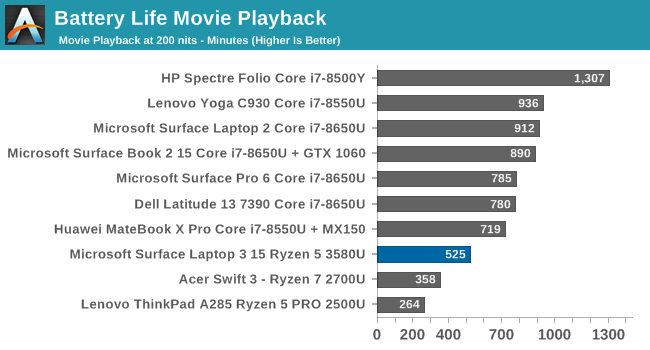
Video playback is one of Intel’s strengths, but it continues to be one of AMD’s weaknesses, with video playback time far shorter than the Intel offerings. Intel has put a lot of effort into offloading the video playback to fixed function hardware and turning the rest of the chip off, and while AMD certainly has hardware decode on their APU, it clearly can’t turn off the rest of the chip during playback, since the battery run time is somewhat less than our light web test.
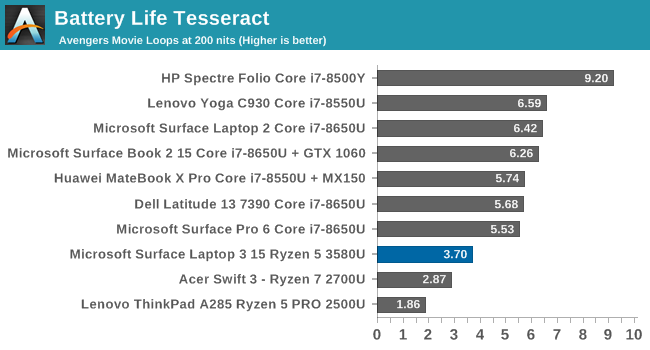
On the Tesseract score, the Surface Laptop 3 is still able to watch almost four entire sittings of The Avengers, which is a lot, but well under the 6.4 plays on the Surface Laptop 2.
Normalized Results
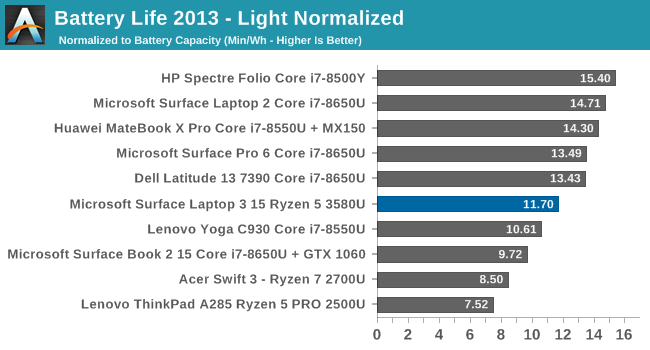
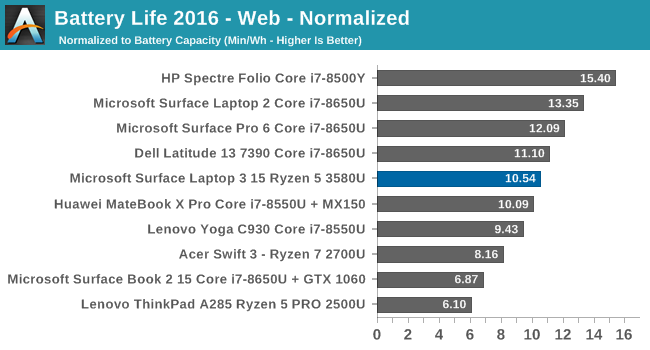
Removing the battery size from the runtimes lets us look at overall platform efficiency during the tests, and removes the insane runtime the Surface Book 2 provides thanks to its massive battery. Here the results are mixed. AMD has certainly made some tremendous strides in improving the abysmal platform power of the Ryzen APU from the original Raven Ridge to the current Picasso platform, with a much better showing in both the light test and 2016 Web results. Some of the discrepancy would come down to the display as well, since the larger 15-inch IGZO panel will need more power to light up to 200 nits than an equivalent 13.5-inch that we see in the Surface Laptop 2, but AMD definitely has more work to do in order to bring Ryzen's platform power down to what Intel has achieved.
The Acer Swift 3, which was the first Raven Ridge laptop we tested, drew 5.71 watts of power at idle with the display at 200 nits. That actually compares favorable with a Surface Book 2 15, which draws about the same – 5.53 Watts at idle with the display at 200 nits, but the main difference is the Surface Book 2’s display is the majority of the power draw thanks to its high resolution and 15-inch size. Removing display power from the devices results in the Acer Swift 3 drawing 4.55 watts at idle, and the Surface Book 2 drawing just 1.43 watts. The HP Spectre Folio, which features a Core i7 Y series processor, draws just 750 mW of power at idle.
The Surface Laptop 3 draws right around 5 Watts of power at idle with the display at 200 nits. That’s once again similar to the Surface Book 2 15, which draws 5.53 Watts. However, the Surface Laptop 3’s lower resolution display accounts for much less of the total platform draw. Removing the display from the equation results in the Surface Laptop 3 still drawing 2.35 Watts at idle. That’s significantly more than an Intel platform. So, while AMD has improved their battery draw tremendously, 2.35 Watts of idle power draw is still a lot and leads to the 15-inch Surface Laptop 3 delivering less battery life than the Surface Laptop 2, which was 8th generation Intel.
Charge Time
To make up for the less than amazing battery life of the Surface Laptop 3, Microsoft does include a stout 65-Watt charger which connects to the Surface Connect Port. All Surface power bricks also include an integrated USB-A output which is very handy when traveling if you need to charge your phone, although they may need to add USB-C soon.
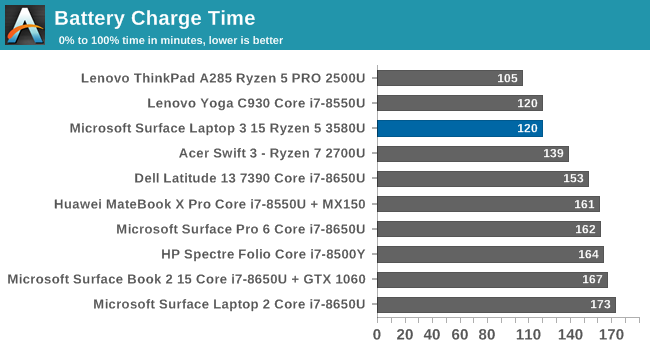
The Surface Laptop 3 charged very quickly. The smaller than average battery sized coupled with a larger than average adapter gave Microsoft lots of capacity to quickly get the Laptop 3 back up to a full charge.










91 Comments
View All Comments
id4andrei - Monday, October 21, 2019 - link
Read on the verge how this CPU struggles playing 4k video on youtube(on Edge). Is that a known issue of AMD CPUs?revivedblazejr - Tuesday, October 22, 2019 - link
Edge has issues with playing 4k videos on integrated graphic cards from a long time. if you have a better discrete graphics card, it would use it and scale the resolution. i have been facing this issues from 2018, upgraded to a 1080ti and it works well. i think it is on browser's end and idk if they have fixed it yet.IntelUser2000 - Monday, October 21, 2019 - link
"Unfortunately AMD doesn't offer an equivalent here, so Microsoft is using a Qualcomm wireless adapter in the AMD-based 15-inch Surface Laptop 3."They could have just used the Intel wireless instead. They offer non-CNVi versions. If you see AMD motherboards with integrated WiFi they all feature Intel wireless.
inighthawki - Monday, October 21, 2019 - link
I would really love if this review was able to compare with the 15" Ice Lake variants they sell in the business store. Or at very least compare it to the 13.5" version so we can see the basic differences in performance between Ice Lake and Zen+. I have a sneaking suspicion that ice lake wins out in almost every metric including battery life on the 15" model, but I'd love to see that actual comparison.Brett Howse - Monday, October 21, 2019 - link
Sorry we only got the 15" to review. We have other ice lake laptops coming though.inighthawki - Monday, October 21, 2019 - link
Thanks Brett. No worries! Appreciate the review for what it is!Dug - Monday, October 21, 2019 - link
This is too bad. I really like the form factor. Very light for a 15". Great screen, great aspect ratio, keyboard, and touchpad.But with poor battery and wifi, it just doesn't make sense.
I'm one that really likes the alcantara on the deck, and would miss that. It always feels nice, and does not get dirty like the utubers want you to believe.
0iron - Tuesday, October 22, 2019 - link
On a bright side, there's high chance next year Surface will come out with Renoir. There is always next year 😄hanselltc - Tuesday, October 22, 2019 - link
So why exactly does amd wait 9 months to release the mobile verisons of their now 9 months old cpu's? This is a very bad showing of zen aside ice lake.Silma - Tuesday, October 22, 2019 - link
I'm somewhat disappointed by the AMD performances.Yes it delivers much better graphics than Intel's IGP, but it's still a joke compared to a graphic card.
MS is to be lauded for offering AMD as a choice though.